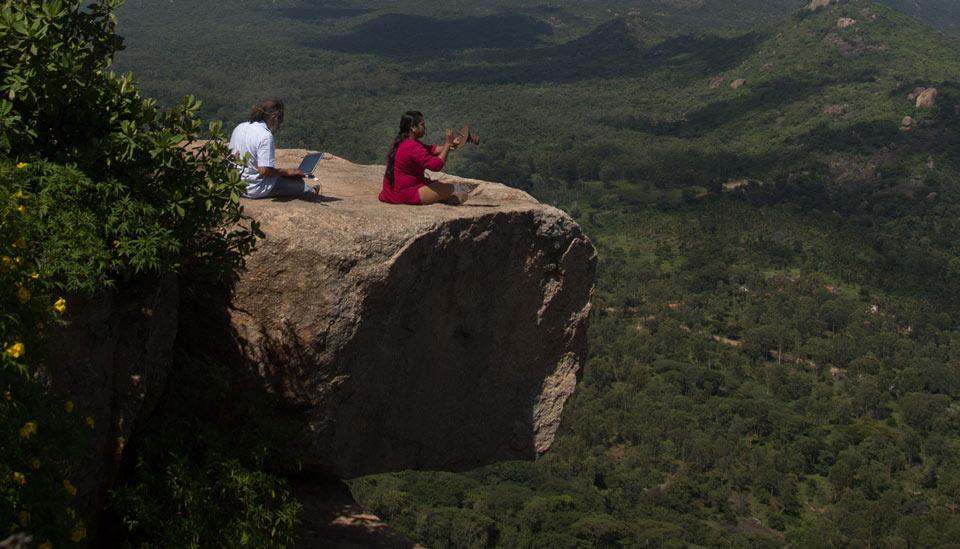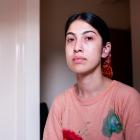
Image description: Two people check equipment on top of hill. Photograph by Gayatri Ganju.
Durgadahalli is a little village that sits snug at the foot of the Devrayanadurga hills that form the outer layer of the ancient Halekote fort. Here set between fields of millet and coconut plantations is the craft centre set up by a local organisation, Janastu. At the craft centre is a small team of people completely engrossed in their work, weaving products from sustainable, locally sourced materials. Here, there’s an immense sense of pride in the work that’s been done because the team are all master craftspeople in their own rights and are involved in applying their traditional skills to innovating new functional designs in the products they make.
Here, there’s an immense sense of pride in the work that’s been done because the team are all master craftspeople in their own rights and are involved in applying their traditional skills to innovating new functional designs in the products they make.
This bustling centre was built from the ground up by hand, involving the community about a year ago. It also houses the edit-room for the local radio station Janastu helped set up, called ‘Namma School Radio’ which means ‘Our School Radio’. This participatory radio has two telephone booths in the village (one placed at the centre) where members of the community can come record messages which then get uploaded on to live database. This content is curated and streamed by 3 young girls from the village who are currently running the radio. Once they’re done with school and freshened up, Lakshmi, Ramya and Kusuma visit the edit-room where they listen in on the new material recorded in the day, curate it and set it up for broadcasting. They have a program plan for the next couple of months that deals with a diverse set of themes like village life, women’s health, sustainable practices and even radio plays written by them.
Apart from being run by these three young girls from the village the success in this program lies in the fact that it involves the larger community as well. With children sitting with their elders, engaging in an organic way to understand their community values. The girls talk to their grandmothers about traditional healing and medicinal practices which gives them holistic knowledge on the environment they live in and the relationship they share with it. They also work with their teachers and run summaries of their school lessons on air, which becomes an important learning resource. They go into the field and collect folk songs and local legends towards building an indigenous archive, conduct interviews with young and old from the village and provide them with a platform to express themselves.
One of the core values leading this project is that tech can be for people from different domains – rural, urban, from minority communities. The question being how this has to re-shape or extend itself to the needs of a particular context. One of the solutions Janastu apply to this question is by building community-based knowledge management systems such as Namma School Radio.
Janastu works with finding context-sensitive IT solutions in rural environments and building inclusive community networks that can be self-sustained. Initially, the project was met with some reservation, as told to us by Dinesh one of the founding members of Janastu. Over time, the youth from the village became increasingly involved and overall participation and goodwill grew. In my time there I saw 13-year-old Lakshmi approaching and engaging with older women, collecting recipes, talking with a farmer to whom she posed questions about the challenges he was facing with his crop. She was imbued with a complete sense of confidence as she did this and told me that her work at the radio fills her with a sense of purpose.
30-year-old Asha from this same village is a young mother of two boys and has also had her life turned around with the arrival of more tech. She was one of the first people to come forward and volunteer support to Janastu. In the early stages of the project, when they were experimenting with setting up a wifi network for the village Asha’s home housed one of the primary nodes. She was also given a tablet so that she could broaden her tech literacy, by photographing and documenting things from her everyday to add to the archive - and this is an archive built by and for the community. With this she had an idea to set up a home-run catering business, (there was nothing of its kind in the village). A year later she is the primary earning member in her family, her husband works with her to support her business and they have been able to carve out a self-sufficient entrepreneurial role for themselves.
Along similar lines, the idea with the craft centre was to bring the past into the future and build a space that generates alternative employment possibilities for the local community. Here the craftspeople, work with locally sourced and completely sustainable materials, using traditional techniques of weaving to make their products. They’re also working with entrepreneurs from big cities like Bangalore to develop new products (on-the-go re-usable cutlery) with these same materials and methods.
The craft centre and the radio have become powerful mediums of preserving and passing on culture. There is a symbiotic inter-generational dynamic at play here, especially for the women from the village who have taken the front seat in their engagement. Making people their own content creators and curators, is a positive shift towards a more empowered and connected community.
Making people their own content creators and curators, is a positive shift towards a more empowered and connected community.

Lakshmi (left) and Kusuma listen in on the day's recordings from the and cue up a playlist to broadcast from Namma School Radio.


Lakshmi and Bhumika collect stories from an older woman in the village. Bhumika, who's only 7 asks to hear a story about a cat and all 3 of them start laughing. This was a beautiful illustration of how the radio has really called in members from the whole community and really strengthened intergenerational exchange.


Asha has started a catering business out of her home which supports her young family. She was one of the first people from Durgadahalli to get excited about the potential of all the tech solutions Janastu were brining in to the village.

Siddava has been weaving baskets and working with natural fibres for over 20 years. Due to severe drought in her village she moved to Durgadahalli with her family and works with her husband who is also a master craftsman at the community centre set up by Janastu.


Lakshmi and Ramya walk through the village one evening after school. They're on their way to meet elders from the village and collect folklore, which is traditionally passed on from one generation to the other orally. The girls tell us that these stories aren't written down anywhere and are slowly being forgotten, which is why they want to record them.


- 6676 views







Add new comment